
FIVE FARM RECIPES YOU CAN DRINK
07/10/20 — Ada Broussard
 Perhaps the most adventurous way to drink your veg this summer is this tomato soda. Recipe and photo by Makenzie Smith. Linked below!
Perhaps the most adventurous way to drink your veg this summer is this tomato soda. Recipe and photo by Makenzie Smith. Linked below!
Happy Friday! Three quick reminders before we dive into this week’s main post.
- CSA Members: Did you know that we have a CSA Referral Program? Our CSA Program no longer has a waitlist (wahoo!), and so all of your friends are cordially invited to join in on the veggie-fun! If you a refer a friend to our CSA Program, you get $20 and they get a free box. To refer a friend, simply tell them your referral code. You can find your referral code in the upper right corner of your “My Deliveries” page. When your friend joins the CSA and enters your unique referral code at checkout, you’ll get a $20 credit and they’ll get a free box. Shoot us an email if you have any questions!
- We have three new CSA Pickup Locations that we want you to know about: Texas Blooms and Gifts (in Austin near the Triangle), North Lamar (off of Cannoneer Lane), as well as a new site serving the Hurst, Texas area. If you’re interested in switching your current pickup locations to one of these new sites, just shoot us a message. To see the sites on a map, click here.
- Just a friendly reminder that this veggie storage guide exists. Storing your vegetables properly is most important during these hot summer days. Speaking of…
Have you looked at the forecast for the next week? If not, we hate to be the bearer of bad news, but it’s going to be brutal. We’re talking multiple days mucking through triple-digit temperatures. Many pools are closed, but there are alternatives. Bring back the ice-bucket challenge or do like we do at the farm, and simply spray your friend off with a hose (most can reach 6-feet). You can curbside an inflatable pool, or for the committed among you, invest in a stock tank pool. They’re all the rage this quarantine. This week on the blog, we’re here to suggest 5 sippable recipes that will help get you through this upcoming heatwave. We’re usually in the business of suggesting how to eat our produce, but it just seems right to drink some veg during the hottest days. Staying hydrated will, in fact, help keep your body temperature down.

Some of the recipes below are boozy, and technically, drinking alcohol won’t help to cool you down. If you’re aiming for pure hydration, the three recipes below that contain alcohol would be absolutely delicious without the booze. If your inflatable pool is waiting in the shade and you’re aiming to libate, the two recipes below that do not contain alcohol would be absolutely delicious with the addition of a jig or two. Booze or not, we hope you cheers your way through these hot, hot days. We certainly will!
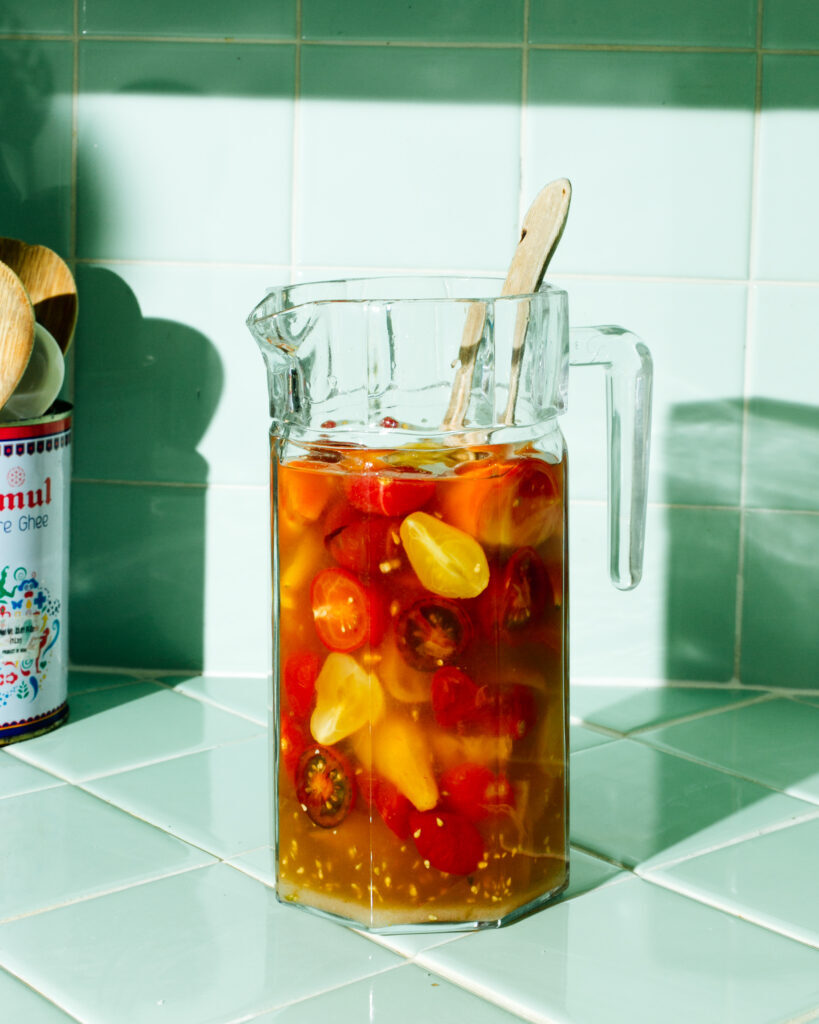 Tomato (or tomato and peach) shurb. You heard it here first, y'all. Tomato soda might just be the next big thing. Recipe and photo by Mackenzie Smith.
Tomato (or tomato and peach) shurb. You heard it here first, y'all. Tomato soda might just be the next big thing. Recipe and photo by Mackenzie Smith.
1. Mackenzie's Tomato Soda
When you grow thousands of pounds of tomatoes every year, you end up eating your fair share of the fruit. As farmers, we thought we had surely tried just about every way there is to enjoy fresh tomatoes, but boy were we wrong. When Mackenzie Smith suggested we make a shrub with tomatoes, our minds were blown. This recipe is such a simple and delicious way to preserve the taste of summer. If you're new to shrubs, this vineargy concoction is often made with fruit and berries, and the resulting sweet and syrupy concoction makes a wonderful addition to a glass of sparkling water.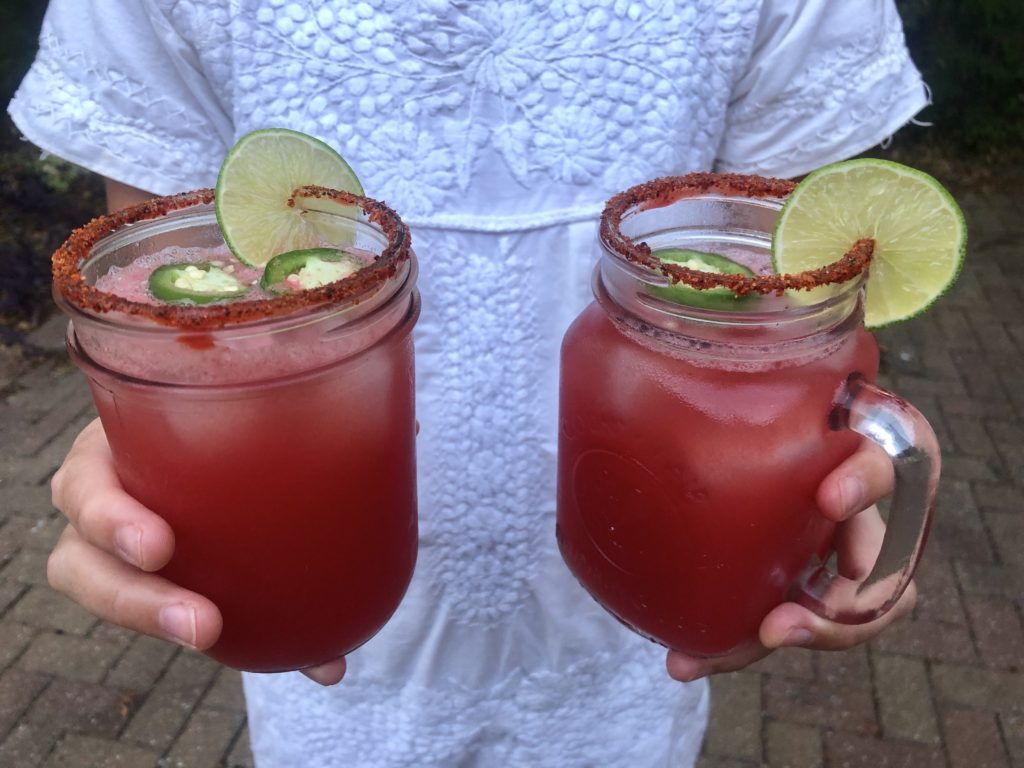 Megan keeps these mason jars in her freezer, margarita ready at all times. Photo courtesy of Meg.
Megan keeps these mason jars in her freezer, margarita ready at all times. Photo courtesy of Meg.
2. Megan's Spicy Watermelon Margarita
At the core of this recipe is the simple technique for making watermelon juice at home. Add tequila (and some spice) and you've got Megan's margarita, but you could also adapt this recipe and simply add mint and cucumber to the watermelon juice for instant hydration. We hope you're not thirsty when you look at this picture because there is something about these giant mason jars full of iced down watermelon juice that really has us hankering for a sip.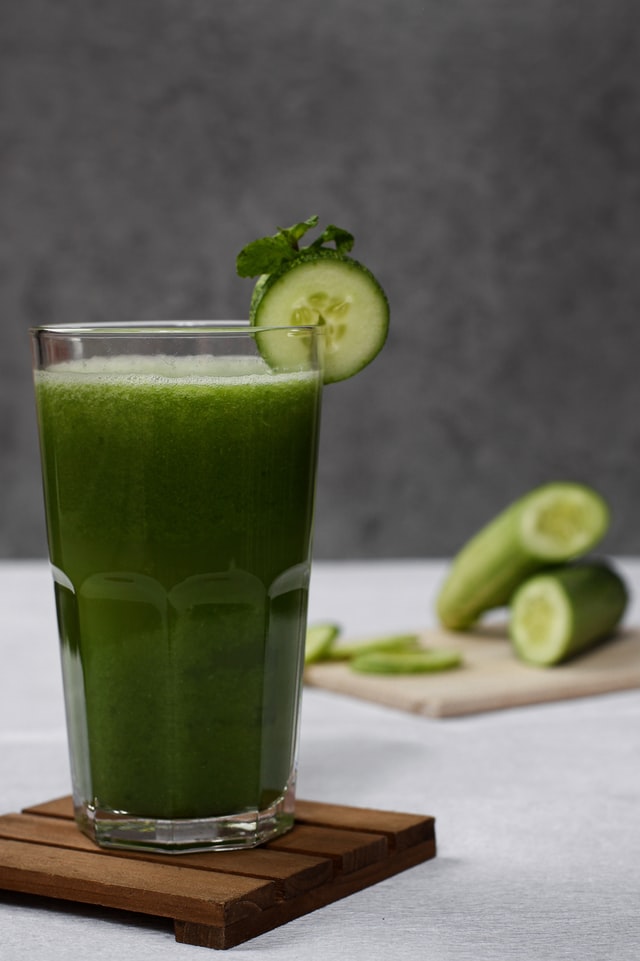
3. Anne's Cool as a Cucumber Juice
Last summer we sat down with local acupuncturist, Anne Woods Miller, to talk about how to beat the heat. In addition to eating more raw foods, Anne also suggested to "add more foods with blue, green, and purple colors to your diet. It's simple, cooling colors cool the body." Scroll to the very end of this blog post for Anne's green summer juice recipe which makes use of cucumbers, mint, and swiss chard... all contents in this week's CSA shares.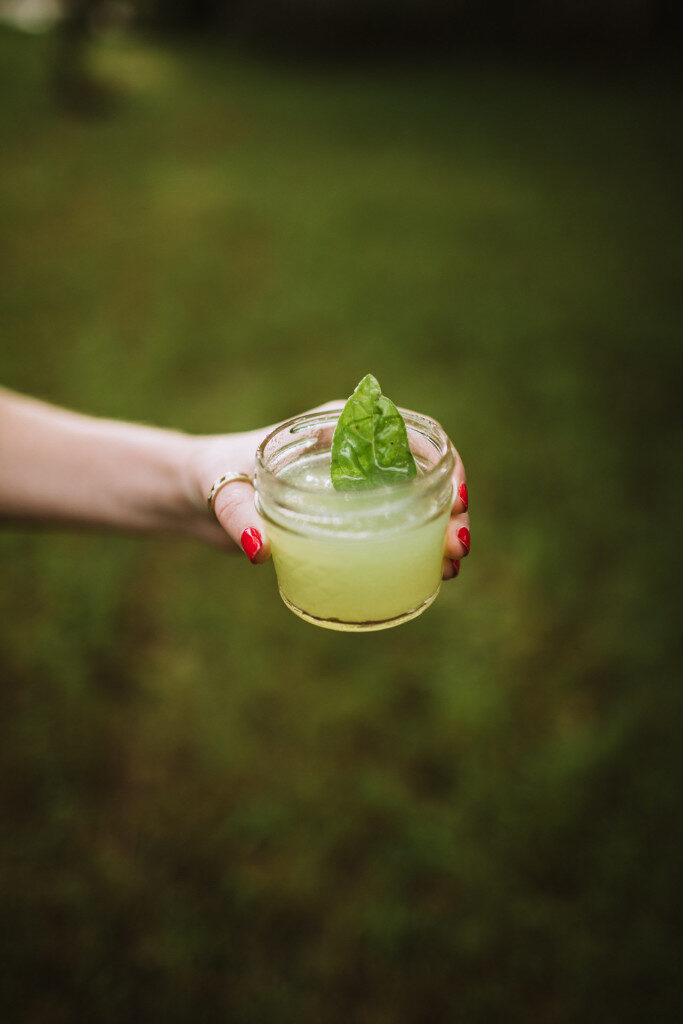 We promise this drink will taste incredible with our without the fire-red nails. Photo by Rick Cortez.
We promise this drink will taste incredible with our without the fire-red nails. Photo by Rick Cortez.
4. Nadia's Honeydew and Green Tomato Gimlet
Wikipedia tells us that a gimlet is "a cocktail typically made of 2 parts gin and 1 part lime juice. A 1928 description of the drink was: gin, and a spot of lime." Nadia's gimlet? She manages to sneak the summer into this classic cocktail, using not one, not two, but three summer classics: honeydew melon, green tomatoes, and basil. Though we're not moving as many green tomatoes at this point in the summer, something tells us Mackenzie's tomato shrub would make a suitable substitution for the green tomato water in this recipe.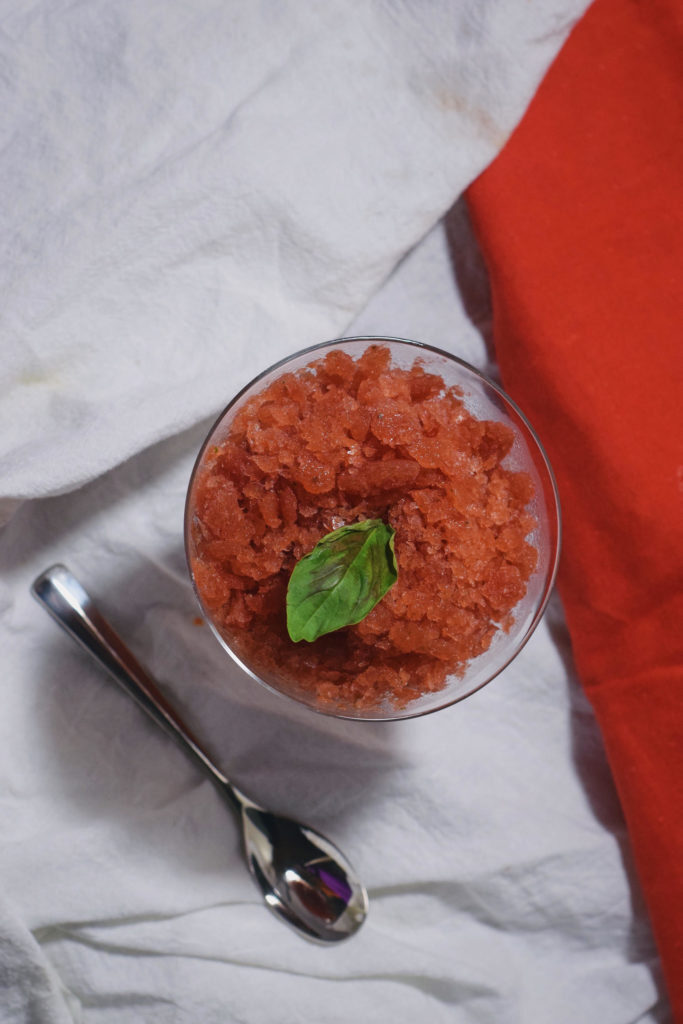
5. Summer's Watermelon, Lime, and Basil Granita
Okay, technically this granita is more easily eaten with a spoon and isn't exactly sippable, but this sorbet-like dessert most certainly deserved a spot in this week's post. "Granita hails from Sicily and is essentially a fancier shaved ice typically made with fresh fruit. You can make granita with any fruit, but we got a perfect mini watermelon + a bunch of fresh basil in our CSA box and this idea was born." Thank you, Summer for embodying your season so well.Bonus Recipe: Krishna's Limeade.
If you're new to the JBG Community, you may not know that our operations manager, Krishna, is an incredible cook. On a very hot day this past October, we spent the day cooking with Krishna. We made huge platters of Indian delicacies for the barn staff to feast on. Many of the recipes featured summer veggies like tomatoes, eggplant, peppers, and potatoes - now is the time to cook this menu if you haven't already! On this day, Krishna introduced us to a simple 4-ingredient drink that is a fresher alternative to Gatorade, perfect for an energizing jolt after a day in the heat. Excerpt from Cooking with Krishna:Lime-ade: The day Krishna and I cooked, it was warm, made warmer by the fact that there was no AC in the farm house we were cooking in. We were hot. After enjoying 1, 2, and then 3 servings of our feast with farm friends, I headed back to the hot kitchen to clean up. Except there was Krishna, drying off the last pot…. Krishna had already cleaned everything. He handed me one of his grandmother’s stainless steel nesting bowls filled with a liquid and said “drink this”. Lime juice, water, salt, and sugar, less diluted than your traditional limeade and leaning more towards “delicious nourishing tonic” than “derby cocktail with straw”.
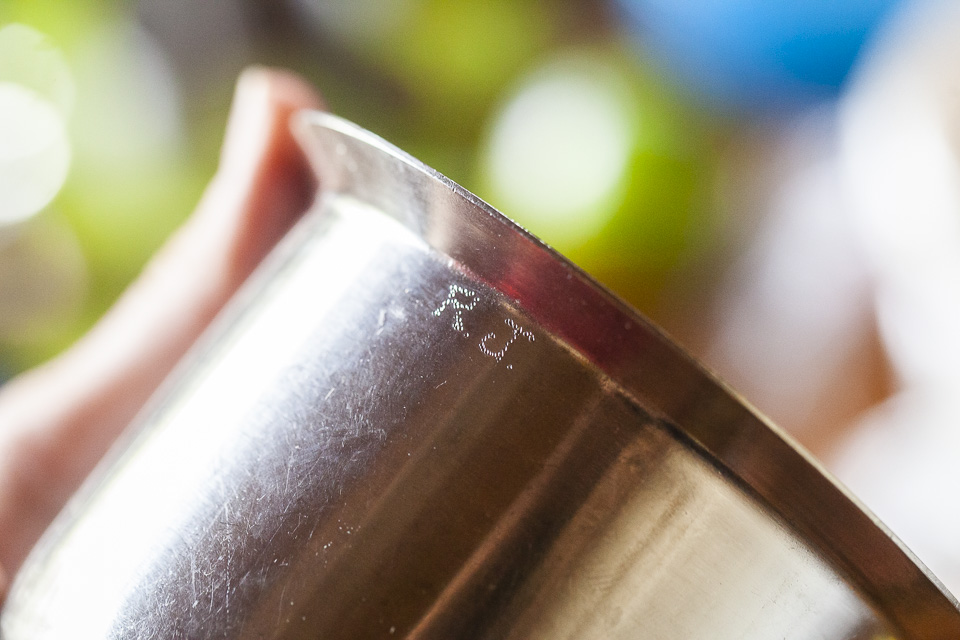 Checkout the original Cooking with Krishna post to learn about the sweet story behind this engraved bowl. Photo by Scott David Gordon.
Checkout the original Cooking with Krishna post to learn about the sweet story behind this engraved bowl. Photo by Scott David Gordon.
SPICY, HERBY BUTTER LETTUCE DELIGHT
07/08/20 — Ada Broussard
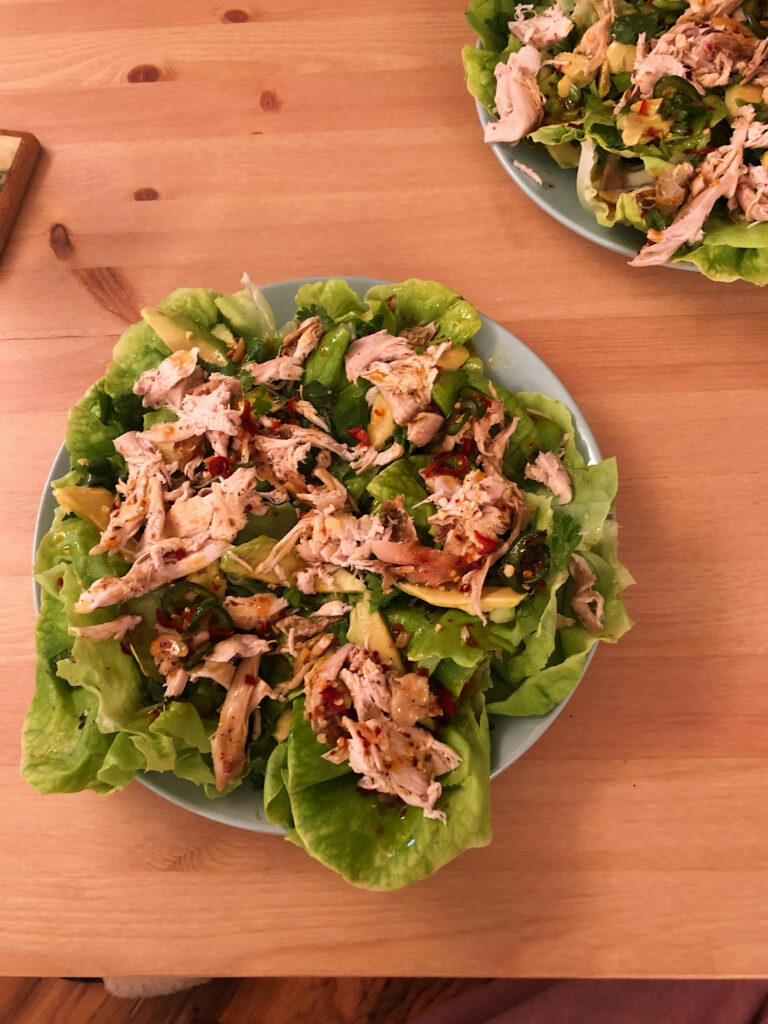
Spicy, Herby Butter Lettuce Delight
By Isaac and Heydon
This salad is amazing. Lately, it’s all I’ve been craving. One night a couple weeks ago, Isaac threw this together when I asked for more “green in my life”. It’s the perfect blend of spicy and fresh. It fills you up but simultaneously feels super light. The recipe we have listed below for the sauce is a loose guide. If you don’t have all the ingredients or want to take it in another direction, more power to you. It should be fun and easy but more importantly, totally delicious.
Sauce Ingredients
- 1 half cup of Olive oil
- 3 to 4 tablespoons of Sesame oil
- 1 to 2 tablespoons of Soy sauce
- 1 to 2 tablespoons of Ponzu sauce
- 1 teaspoon of Fish sauce
- 1 to 2 tablespoons of Worcestershire sauce
- 3 to 4 tablespoons of Rice vinegar
- 1 tablespoon of honey
- The juice of half a lime
- 3 cloves of garlic, minced
- 1/4 cup of toasted cashews, chopped roughly
- ** salt to taste (there is already loads of sodium from the sauces above)
Salad Ingredients
- 2 jalapeños, very thinly sliced
- 4 green onions, thinly sliced
- 1 shallot, finely sliced
- Half a bunch of cilantro, roughly chopped
- 4 to 5 sprigs of mint, roughly chopped
- 2 avocados, sliced medium thin
- 1 head butter lettuce
- 1 rotisserie chicken (regular flavor is ideal)
Combine sauce ingredients and set aside to let flavors meld. Prepare the jalapenos, green onions, shallot, cilantro, and mint, and set aside in a bowl. Slice the avocados, set aside and sprinkle with lime juice and salt. Wash and remove the leaves of the butter lettuce, set aside. Pull about 2 to 3 cups of chicken off of the bird, set aside.
Pour a healthy amount of the sauce in with the pepper and herb mix. Stir lightly, making sure the sauce douses all the ingredients. Place 4 to 5 of the butter lettuce leaves on a plate, and sprinkle pieces of the chicken and avocado over the leaves. Next, spoon the sauced herb and pepper mix over the plated ingredients. Then repeat these two steps, essentially making a two-layer salad. Enjoy!
CSA BOX CONTENTS WEEK OF JULY 6TH
07/06/20 — Scott
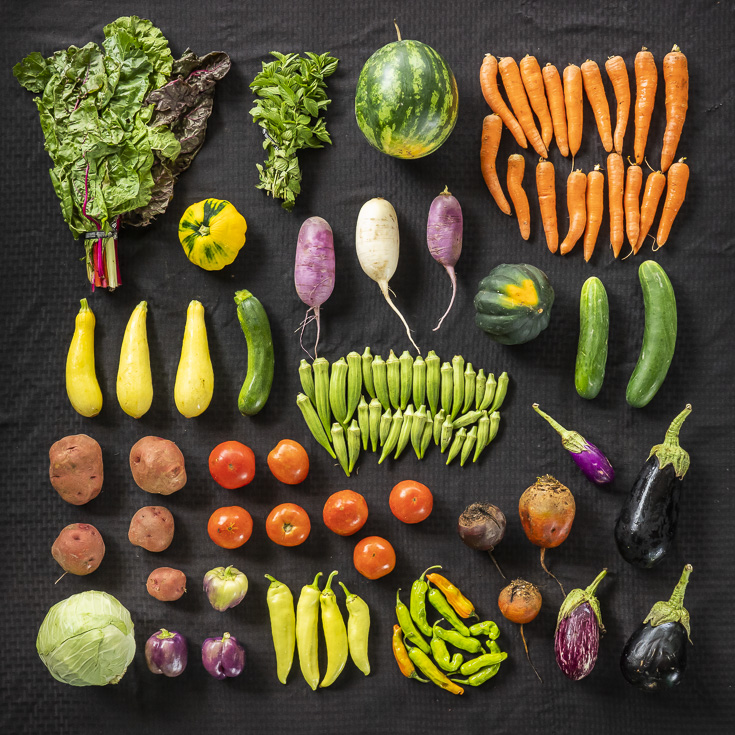 CSA Box Contents Week of July 6th
CSA Box Contents Week of July 6th
Large Box
Beets
Cucumber
Herb, Farmers Choice
Melon, Farmers Choice
Pepper, Hot Medley
Pepper, Shishito
Pepper, Sweet
Potato
Squash, Farmer's Choice
Tomato
Winter Squash
Beets
Cucumber
Herb, Farmers Choice
Melon, Farmers Choice
Pepper, Hot Medley
Pepper, Shishito
Pepper, Sweet
Potato
Squash, Farmer's Choice
Tomato
Winter Squash
Medium Box
Cucumber
Eggplant
Herb, Farmers Choice
Okra
Pepper, Hot Medley
Pepper, Sweet
Potato
Squash, Farmer's Choice
Winter Squash
Cucumber
Eggplant
Herb, Farmers Choice
Okra
Pepper, Hot Medley
Pepper, Sweet
Potato
Squash, Farmer's Choice
Winter Squash
Small Box
Beets
Cucumber
Eggplant
Herb, Farmers Choice
Pepper, Sweet
Potato
Squash, Farmer's Choice
Beets
Cucumber
Eggplant
Herb, Farmers Choice
Pepper, Sweet
Potato
Squash, Farmer's Choice
Individual Box
Beets
Cucumber
Okra
Pepper, Sweet
Potato
Beets
Cucumber
Okra
Pepper, Sweet
Potato
WHAT TO COOK (AND REMEMBER) THIS FOURTH OF JULY
07/03/20 — Ada Broussard
This July 4th is one that we will all likely remember. You’re likely spending the day with a small group, maybe even just your immediate family or chosen quaranteam. Austin parks are closed, bars shuddered, and many parties canceled. But, you’ve still got to eat, no? Our vegetables certainly are still growing, and despite the circumstances of this year’s Independence Day, they beg to be piled high on platters and maybe thrown on the grill.
To keep your weekend simple, we’re going to go ahead and suggest some side dishes for you. What better day to acknowledge this holiday than with dishes that help us remember our country’s past, and look forward with hope and motivation for its future?
This July 4th, cook the summer classics: Squash, Okra, Tomates, and Watermelon.
![]() Who needs a blueberry pie when you can make a tomato one? Photo by Rick Cortez.
Who needs a blueberry pie when you can make a tomato one? Photo by Rick Cortez.
SQUASH: Squash, along with beans and corn, was one of the earliest domesticated crops in the Americas. The three crops together are known as the Three Sisters, but it’s noteworthy that the consumption and domestication of squash likely came first! The earliest evidence of squash cultivation in what is now the United States ranges from 5,000-8,000 years ago, beginning on the east coast but then eventually spreading far and wide across North America making squash (and gourds and pumpkins) an important staple food for indigenous peoples all across the Americas. Squash is easy to germinate and grows effortlessly. It’s deep roots in North America no doubt make it an obvious choice for a summer celebration.
How to enjoy squash this year: Grill your squash over a hot fire, and top with basil: either finely chopped, blended into a pesto, or infused into oil. This Smitten Kitchen recipe is a wonderful starting point. For a heartier dish, she adds white beans and makes a grilled squash and pesto bean salad.
![]() Photo taken from the Smitten Kitchen website. Recipe linked!
Photo taken from the Smitten Kitchen website. Recipe linked!
OKRA Okra arrived in the United States with enslaved West Africans, brought to the new world as food for enslaved people to eat along the passage. Once landed, many of the enslaved planted and cultivated okra in small gardens as a means to supplement the meager rations provided by slave owners. Okra, therefore, became an important source of sustenance, as well as culinary tradition, for many slaves in the Southern United States. Like history itself, the use and popularity of okra expanded and evolved with time. The tropical plant grows well in hot summers and has become a cornerstone of Southern food traditions. Prepare your okra with a healthy dose of introspection and celebration of Black cooking traditions and its impact on Southern foodways.
How to enjoy okra this year: Fry it, of course! Here is one of our favorite fried okra recipes by Tanorria Askew. Tanorria takes her grandmother’s fried okra recipe and adds her Master Chef touch.
![]() Fried okra recipe and photo courtesy of Tannori Askew's Instagram.
Fried okra recipe and photo courtesy of Tannori Askew's Instagram.
TOMATOES Tomato plants are actually native to Central America, and before domestication, the tomato plant grew like wild vines in these tropical regions bearing tiny and very acidic fruit. The Aztec people consumed the tiny fruit for centuries. When Europeans encountered tomatoes in the Americas, they brought the fruit and see back home. Interestingly, many Europeans feared the tomato and considered it poisonous (even nicknaming in the “poison apple” for hundreds of years. Many Europeans were eating on pewter plates and pewter flatware which contained high amounts of lead. Because of tomatoes’ acidity, the fruit would leach lead from the plates, often killing the diners. Of course, those eating off of wooden plates with wooden wares didn’t experience this problem, and tomatoes slowly and surly became a beloved fruit of poorer families, specifically in parts of Spain as well as in Naples, Italy, where pizza was born. The skepticism of the tomatoes carried over to European colonists, though there were rural gardeners who embraced the fruit. It wasn’t until the Civil War that the tomato because a commonplace vegetable. Tomato canneries boomed during this period, and tomatoes’ ability to be preserved this way made them a staple food for the Union army. Enjoy a tomato this holiday, and honor the battles we have faced, and continue to face, to achieve the American ideal.
How to enjoy tomatoes this year: Make a pie. Sure, blueberry pie and peach cobbler are traditional 4th of July foods. But why not make a savory, tomato pie? Here is our favorite tomato pie recipe and here is a tomato galette (or rustic pie) recipe, both from the JBG archives. (P.S. We just counted, and this year we have sold 18,000 lbs. of tomatoes through our Bulk Sale! We still have slicer and cherry tomato varieties available, but the sale will end soon. Order here if you want tomato pies for days!)
![]() Tomato pie crust. Recipe linked above. Photo by Megan Russel.
Tomato pie crust. Recipe linked above. Photo by Megan Russel.
WATERMELON The average high temperature in Austin on the 4th of July is 95 degrees. Each bite of a watermelon is about 91% water (and 6% sugar). Is there any better fruit to enjoy on the Fourth of July? Unfortunately, the enjoyment of a watermelon isn’t as straightforward of delight for Black Americas because the fruit has long been used as a racist trope. This Atlantic article tells the story, “...the stereotype that African Americans are excessively fond of watermelon emerged for a specific historical reason and served a specific political purpose. The trope came in full force when slaves won their emancipation during the Civil War. Free black people grew, ate, and sold watermelons, and in doing so made the fruit a symbol of their freedom. Southern whites, threatened by blacks’ newfound freedom, responded by making the fruit a symbol of black people’s perceived uncleanliness, laziness, childishness, and unwanted public presence.”
This Atlantic article tells the full story better than we can, and we encourage you all to give the complete article a read. We don’t point out this complicated facet of watermelon to dissuade you from slicing one up, and in fact, we hope we’re able to do the opposite! Let this sweet and hydrating fruit nourish us this summer and help invigorate our collective desire to create a better country tomorrow that exists today.
How to enjoy watermelon this year: Sliced, with our without salt.
As always, thank you for reading and thank you for being such a wonderful community for us to farm in. Your support makes the 100 degree days worth it!
![]() Watermelons waiting in the field. Photo by Scott David Gordon.
Watermelons waiting in the field. Photo by Scott David Gordon.
To keep your weekend simple, we’re going to go ahead and suggest some side dishes for you. What better day to acknowledge this holiday than with dishes that help us remember our country’s past, and look forward with hope and motivation for its future?
This July 4th, cook the summer classics: Squash, Okra, Tomates, and Watermelon.
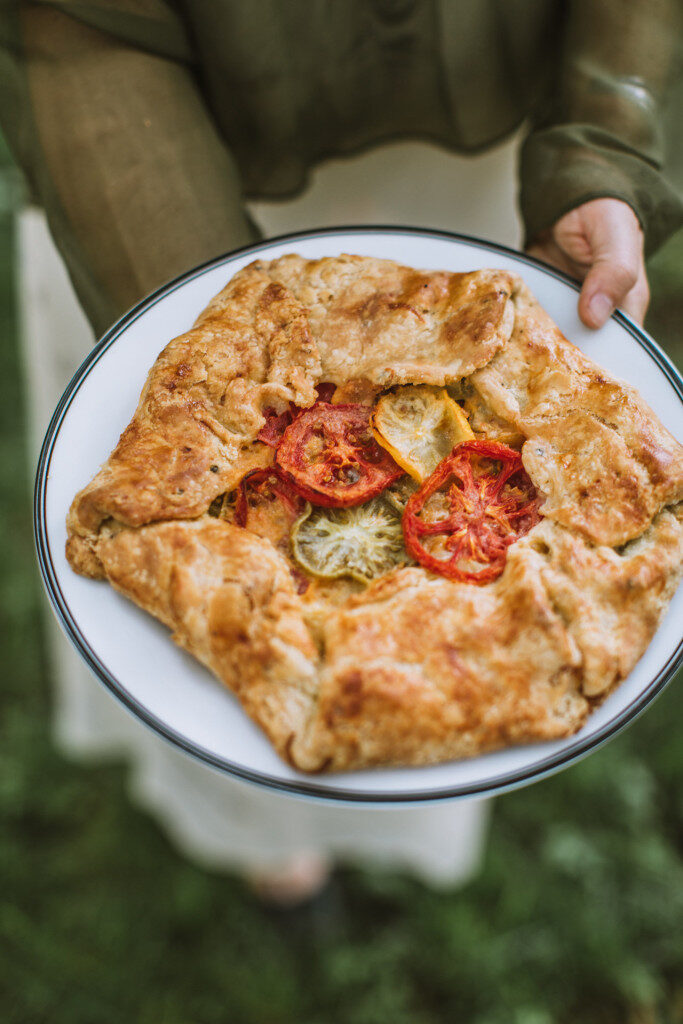 Who needs a blueberry pie when you can make a tomato one? Photo by Rick Cortez.
Who needs a blueberry pie when you can make a tomato one? Photo by Rick Cortez.
SQUASH: Squash, along with beans and corn, was one of the earliest domesticated crops in the Americas. The three crops together are known as the Three Sisters, but it’s noteworthy that the consumption and domestication of squash likely came first! The earliest evidence of squash cultivation in what is now the United States ranges from 5,000-8,000 years ago, beginning on the east coast but then eventually spreading far and wide across North America making squash (and gourds and pumpkins) an important staple food for indigenous peoples all across the Americas. Squash is easy to germinate and grows effortlessly. It’s deep roots in North America no doubt make it an obvious choice for a summer celebration.
How to enjoy squash this year: Grill your squash over a hot fire, and top with basil: either finely chopped, blended into a pesto, or infused into oil. This Smitten Kitchen recipe is a wonderful starting point. For a heartier dish, she adds white beans and makes a grilled squash and pesto bean salad.
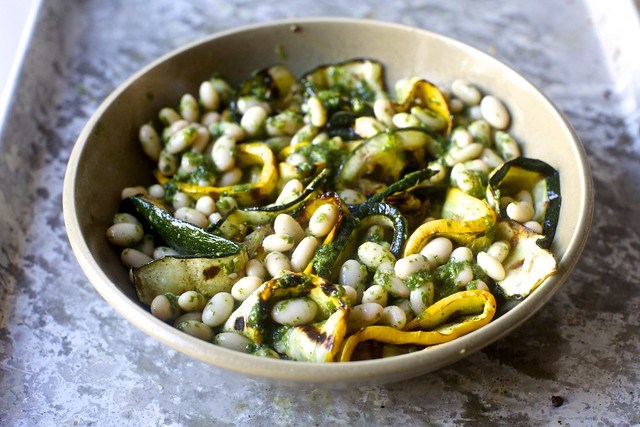 Photo taken from the Smitten Kitchen website. Recipe linked!
Photo taken from the Smitten Kitchen website. Recipe linked!
OKRA Okra arrived in the United States with enslaved West Africans, brought to the new world as food for enslaved people to eat along the passage. Once landed, many of the enslaved planted and cultivated okra in small gardens as a means to supplement the meager rations provided by slave owners. Okra, therefore, became an important source of sustenance, as well as culinary tradition, for many slaves in the Southern United States. Like history itself, the use and popularity of okra expanded and evolved with time. The tropical plant grows well in hot summers and has become a cornerstone of Southern food traditions. Prepare your okra with a healthy dose of introspection and celebration of Black cooking traditions and its impact on Southern foodways.
How to enjoy okra this year: Fry it, of course! Here is one of our favorite fried okra recipes by Tanorria Askew. Tanorria takes her grandmother’s fried okra recipe and adds her Master Chef touch.
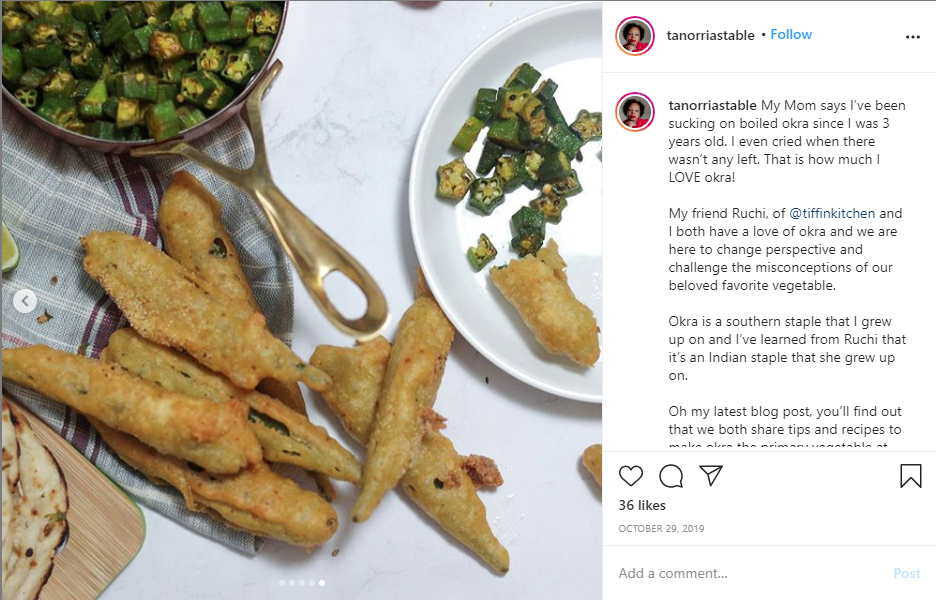 Fried okra recipe and photo courtesy of Tannori Askew's Instagram.
Fried okra recipe and photo courtesy of Tannori Askew's Instagram.
TOMATOES Tomato plants are actually native to Central America, and before domestication, the tomato plant grew like wild vines in these tropical regions bearing tiny and very acidic fruit. The Aztec people consumed the tiny fruit for centuries. When Europeans encountered tomatoes in the Americas, they brought the fruit and see back home. Interestingly, many Europeans feared the tomato and considered it poisonous (even nicknaming in the “poison apple” for hundreds of years. Many Europeans were eating on pewter plates and pewter flatware which contained high amounts of lead. Because of tomatoes’ acidity, the fruit would leach lead from the plates, often killing the diners. Of course, those eating off of wooden plates with wooden wares didn’t experience this problem, and tomatoes slowly and surly became a beloved fruit of poorer families, specifically in parts of Spain as well as in Naples, Italy, where pizza was born. The skepticism of the tomatoes carried over to European colonists, though there were rural gardeners who embraced the fruit. It wasn’t until the Civil War that the tomato because a commonplace vegetable. Tomato canneries boomed during this period, and tomatoes’ ability to be preserved this way made them a staple food for the Union army. Enjoy a tomato this holiday, and honor the battles we have faced, and continue to face, to achieve the American ideal.
How to enjoy tomatoes this year: Make a pie. Sure, blueberry pie and peach cobbler are traditional 4th of July foods. But why not make a savory, tomato pie? Here is our favorite tomato pie recipe and here is a tomato galette (or rustic pie) recipe, both from the JBG archives. (P.S. We just counted, and this year we have sold 18,000 lbs. of tomatoes through our Bulk Sale! We still have slicer and cherry tomato varieties available, but the sale will end soon. Order here if you want tomato pies for days!)
 Tomato pie crust. Recipe linked above. Photo by Megan Russel.
Tomato pie crust. Recipe linked above. Photo by Megan Russel.
WATERMELON The average high temperature in Austin on the 4th of July is 95 degrees. Each bite of a watermelon is about 91% water (and 6% sugar). Is there any better fruit to enjoy on the Fourth of July? Unfortunately, the enjoyment of a watermelon isn’t as straightforward of delight for Black Americas because the fruit has long been used as a racist trope. This Atlantic article tells the story, “...the stereotype that African Americans are excessively fond of watermelon emerged for a specific historical reason and served a specific political purpose. The trope came in full force when slaves won their emancipation during the Civil War. Free black people grew, ate, and sold watermelons, and in doing so made the fruit a symbol of their freedom. Southern whites, threatened by blacks’ newfound freedom, responded by making the fruit a symbol of black people’s perceived uncleanliness, laziness, childishness, and unwanted public presence.”
This Atlantic article tells the full story better than we can, and we encourage you all to give the complete article a read. We don’t point out this complicated facet of watermelon to dissuade you from slicing one up, and in fact, we hope we’re able to do the opposite! Let this sweet and hydrating fruit nourish us this summer and help invigorate our collective desire to create a better country tomorrow that exists today.
How to enjoy watermelon this year: Sliced, with our without salt.
As always, thank you for reading and thank you for being such a wonderful community for us to farm in. Your support makes the 100 degree days worth it!
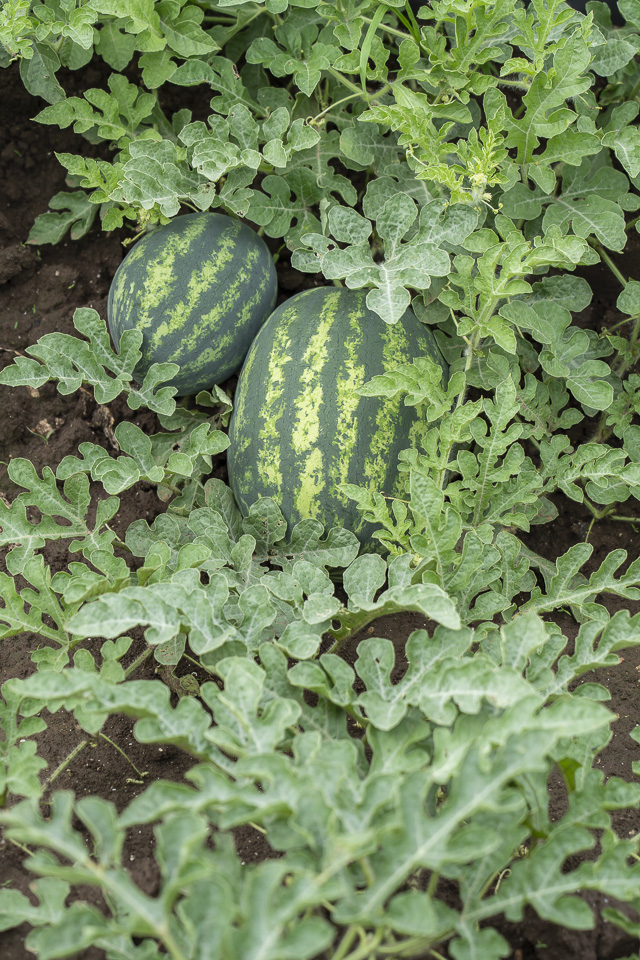 Watermelons waiting in the field. Photo by Scott David Gordon.
Watermelons waiting in the field. Photo by Scott David Gordon.PHOTOS FROM THE FARM: 7.3.2020
07/03/20 — Ada Broussard
Last week, Scott's trip to the farm got rained out. This week, the vegetables were really showing off for Scott - sporting electric colors seemingly fueled by recent rains and scorching heat.
![]() Wearing gloves to harvest vegetables is standard food safety policy at the farm. When picking hot peppers, they give the added benefit of spice protection! Photo by Scott David Gordon.
Wearing gloves to harvest vegetables is standard food safety policy at the farm. When picking hot peppers, they give the added benefit of spice protection! Photo by Scott David Gordon.
![]() Melon mania has begun! Just in time for these 100 degree days. Photo by Scott David Gordon.
Melon mania has begun! Just in time for these 100 degree days. Photo by Scott David Gordon.
![]() Jack making sense of greenhouse inventory. Photo by Scott David Gordon.
Jack making sense of greenhouse inventory. Photo by Scott David Gordon.
![]() The perfect partner for a cold watermelon. Photo by Scott David Gordon.
The perfect partner for a cold watermelon. Photo by Scott David Gordon.
![]() Freshly harvested dandelion greens in the protective shade of our delivery-turn-harvest van. Photo by Scott David Gordon.
Freshly harvested dandelion greens in the protective shade of our delivery-turn-harvest van. Photo by Scott David Gordon.
![]() A tropical plant, okra was brought to America via the transatlantic slave trade. Photo by Scott David Gordon.
A tropical plant, okra was brought to America via the transatlantic slave trade. Photo by Scott David Gordon.
![]() One of our favorite fried okra recipes is up on the blog. How do you fry your okra? Photo by Scott David Gordon.
One of our favorite fried okra recipes is up on the blog. How do you fry your okra? Photo by Scott David Gordon.
![]() A mess of tendrils. Photo by Scott David Gordon.
A mess of tendrils. Photo by Scott David Gordon.
![]() A withered once-was-flower attached to a ridged pattypan squash. Photo by Scott David Gordon.
A withered once-was-flower attached to a ridged pattypan squash. Photo by Scott David Gordon.
![]() We usually plant rows of basil in between 7-8 rows of tomatoes, and harvesting basil is a breezy reprieve from standing in the towering tomatoes. Photo by Scott David Gordon.
We usually plant rows of basil in between 7-8 rows of tomatoes, and harvesting basil is a breezy reprieve from standing in the towering tomatoes. Photo by Scott David Gordon.
![]() Did you know that jalapenos will ripen to red? Red jalapenos spend more time ripening on the vine and have more time to develop capsaicin - the chemical that gives a pepper its spice. Hence, red jalapenos pack more of a punch than younger green ones. Photo by Scott David Gordon.
Did you know that jalapenos will ripen to red? Red jalapenos spend more time ripening on the vine and have more time to develop capsaicin - the chemical that gives a pepper its spice. Hence, red jalapenos pack more of a punch than younger green ones. Photo by Scott David Gordon.
![]() This summer we trialed a new variety of jalapenos that are bigger! Can you believe the size on these peppers? It certainly makes for easier picking. Photo by Scott David Gordon.
This summer we trialed a new variety of jalapenos that are bigger! Can you believe the size on these peppers? It certainly makes for easier picking. Photo by Scott David Gordon.
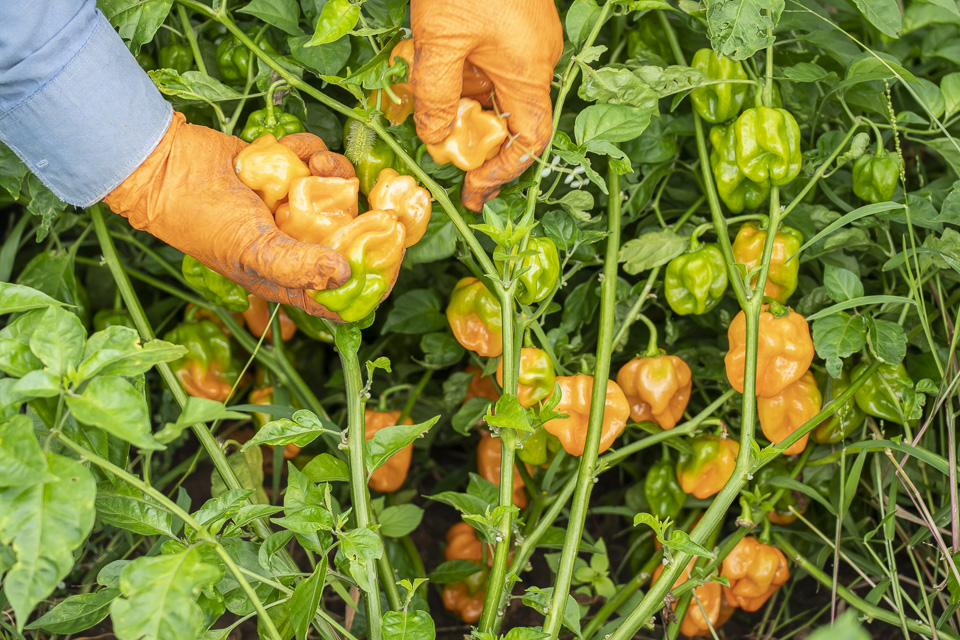 Wearing gloves to harvest vegetables is standard food safety policy at the farm. When picking hot peppers, they give the added benefit of spice protection! Photo by Scott David Gordon.
Wearing gloves to harvest vegetables is standard food safety policy at the farm. When picking hot peppers, they give the added benefit of spice protection! Photo by Scott David Gordon.
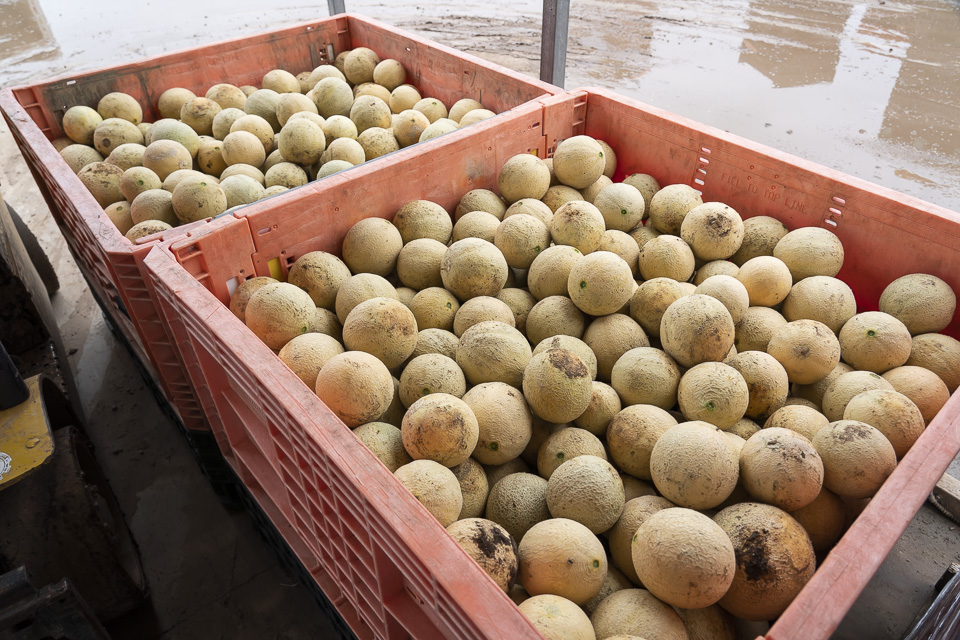 Melon mania has begun! Just in time for these 100 degree days. Photo by Scott David Gordon.
Melon mania has begun! Just in time for these 100 degree days. Photo by Scott David Gordon.
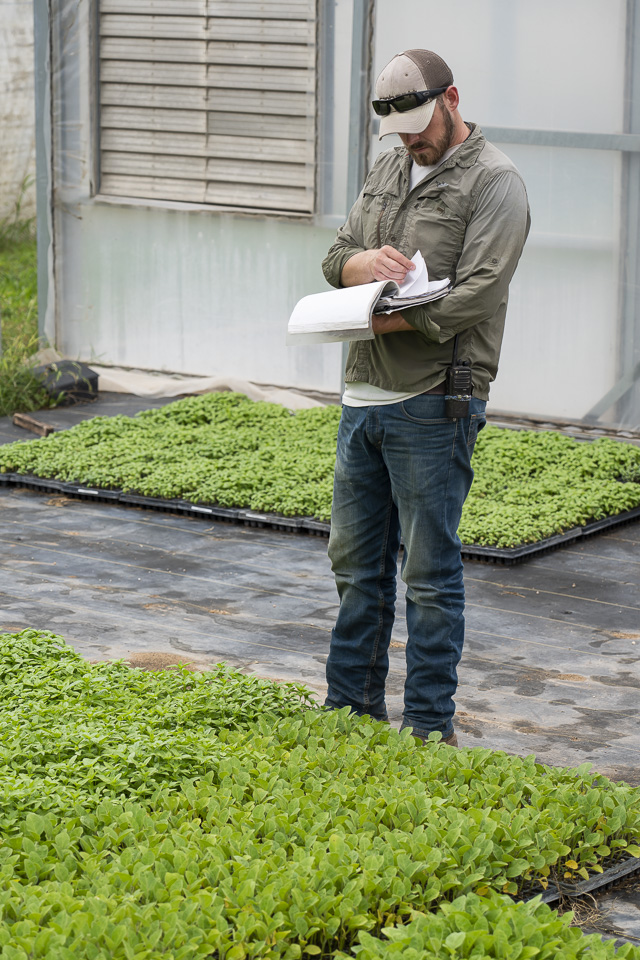 Jack making sense of greenhouse inventory. Photo by Scott David Gordon.
Jack making sense of greenhouse inventory. Photo by Scott David Gordon.
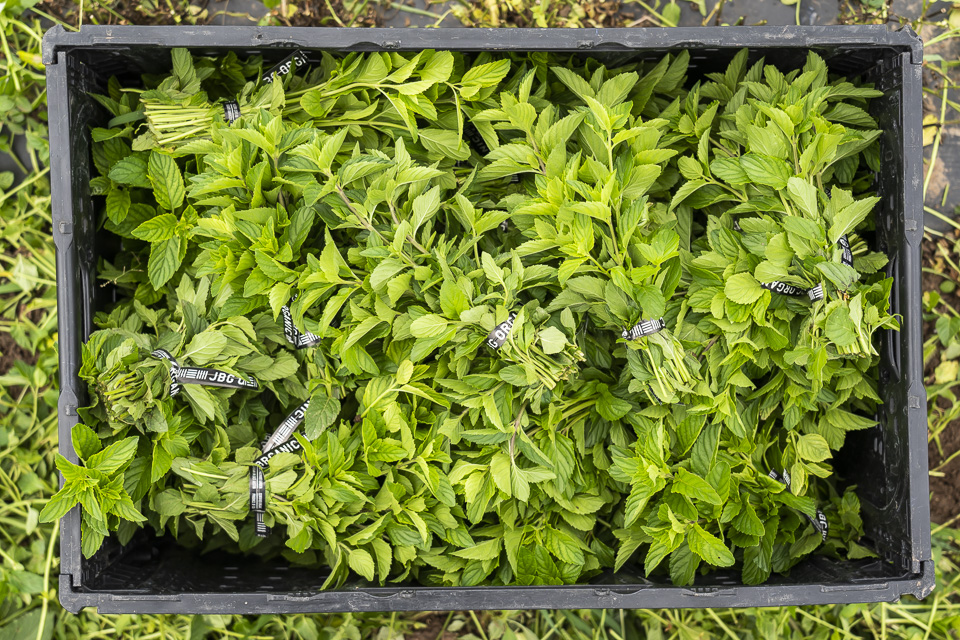 The perfect partner for a cold watermelon. Photo by Scott David Gordon.
The perfect partner for a cold watermelon. Photo by Scott David Gordon.
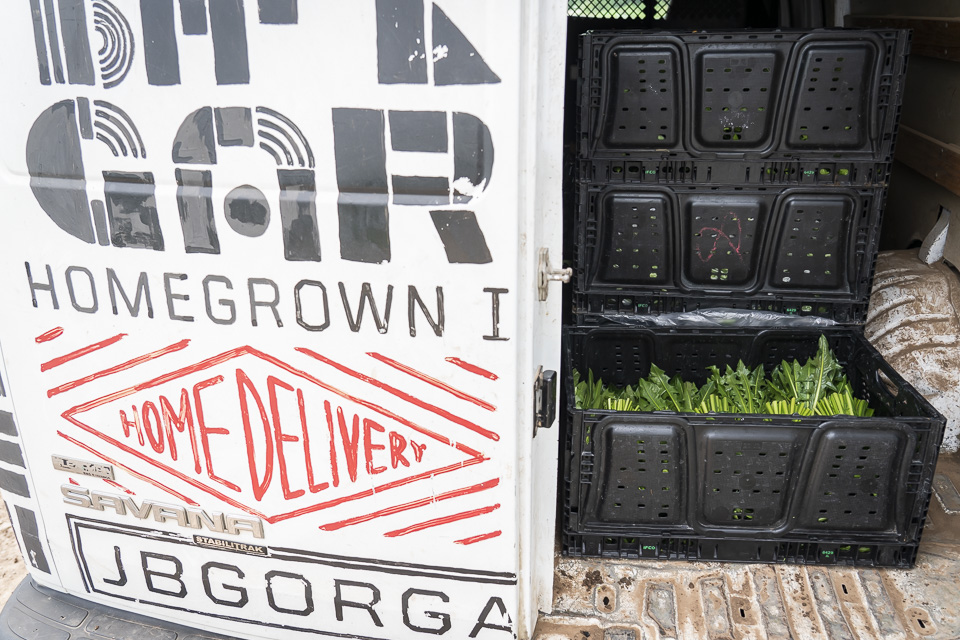 Freshly harvested dandelion greens in the protective shade of our delivery-turn-harvest van. Photo by Scott David Gordon.
Freshly harvested dandelion greens in the protective shade of our delivery-turn-harvest van. Photo by Scott David Gordon.
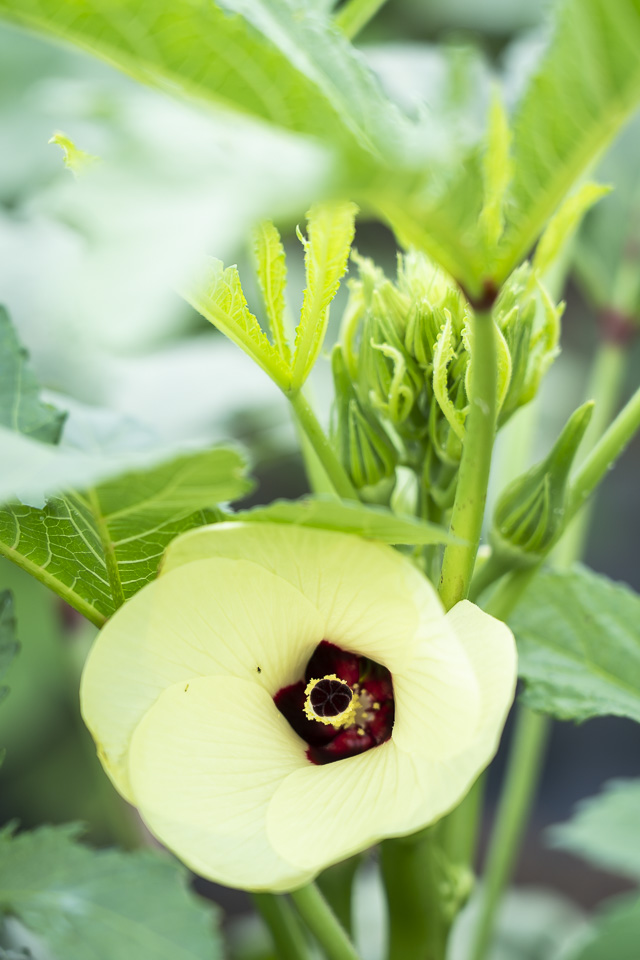 A tropical plant, okra was brought to America via the transatlantic slave trade. Photo by Scott David Gordon.
A tropical plant, okra was brought to America via the transatlantic slave trade. Photo by Scott David Gordon.
 One of our favorite fried okra recipes is up on the blog. How do you fry your okra? Photo by Scott David Gordon.
One of our favorite fried okra recipes is up on the blog. How do you fry your okra? Photo by Scott David Gordon.
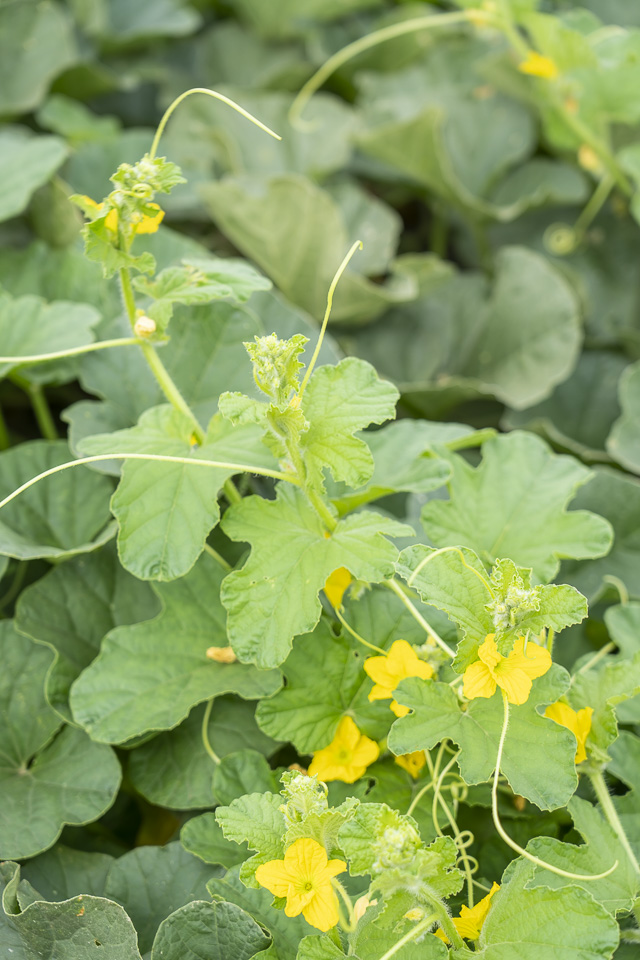 A mess of tendrils. Photo by Scott David Gordon.
A mess of tendrils. Photo by Scott David Gordon.
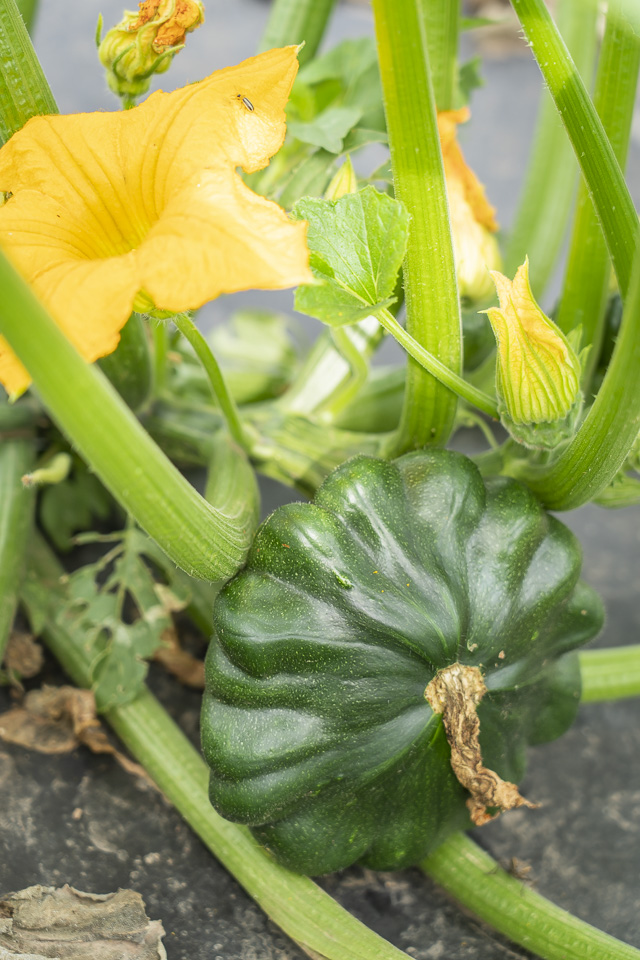 A withered once-was-flower attached to a ridged pattypan squash. Photo by Scott David Gordon.
A withered once-was-flower attached to a ridged pattypan squash. Photo by Scott David Gordon.
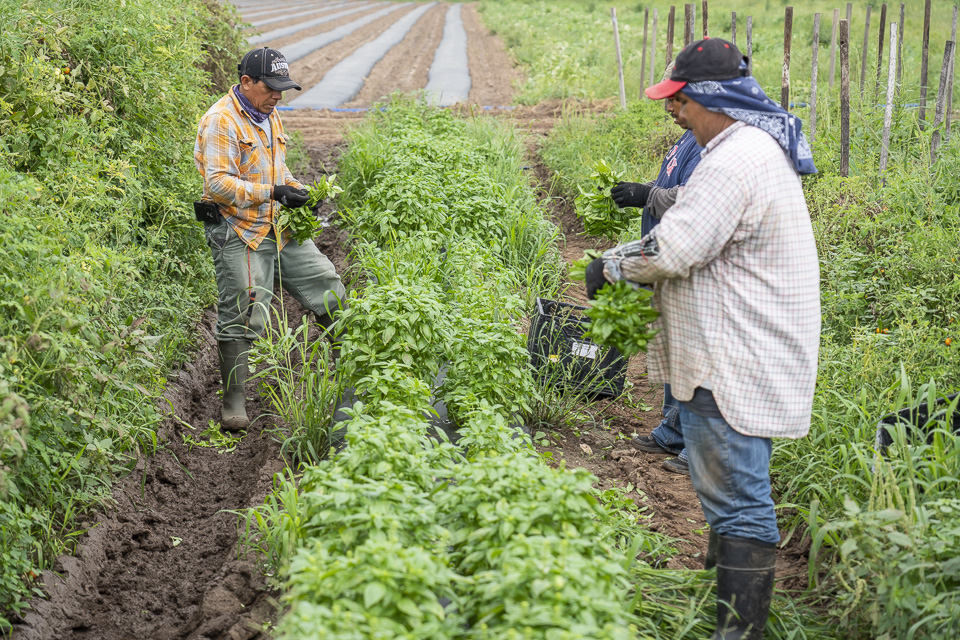 We usually plant rows of basil in between 7-8 rows of tomatoes, and harvesting basil is a breezy reprieve from standing in the towering tomatoes. Photo by Scott David Gordon.
We usually plant rows of basil in between 7-8 rows of tomatoes, and harvesting basil is a breezy reprieve from standing in the towering tomatoes. Photo by Scott David Gordon.
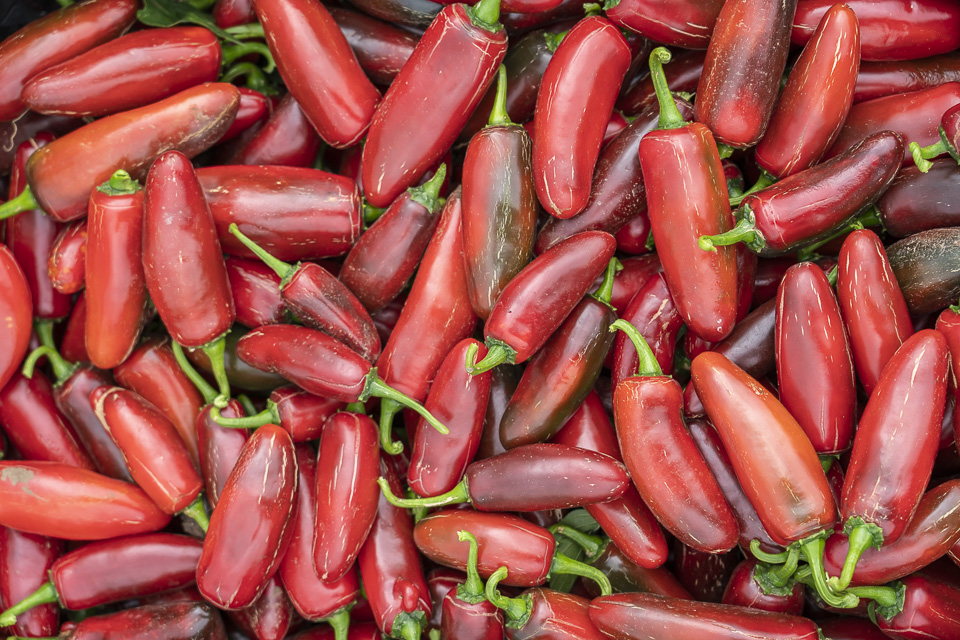 Did you know that jalapenos will ripen to red? Red jalapenos spend more time ripening on the vine and have more time to develop capsaicin - the chemical that gives a pepper its spice. Hence, red jalapenos pack more of a punch than younger green ones. Photo by Scott David Gordon.
Did you know that jalapenos will ripen to red? Red jalapenos spend more time ripening on the vine and have more time to develop capsaicin - the chemical that gives a pepper its spice. Hence, red jalapenos pack more of a punch than younger green ones. Photo by Scott David Gordon.
 This summer we trialed a new variety of jalapenos that are bigger! Can you believe the size on these peppers? It certainly makes for easier picking. Photo by Scott David Gordon.
This summer we trialed a new variety of jalapenos that are bigger! Can you believe the size on these peppers? It certainly makes for easier picking. Photo by Scott David Gordon.CURRIED CARROT AND SWEET POTATO SOUP
07/01/20 — Ada Broussard
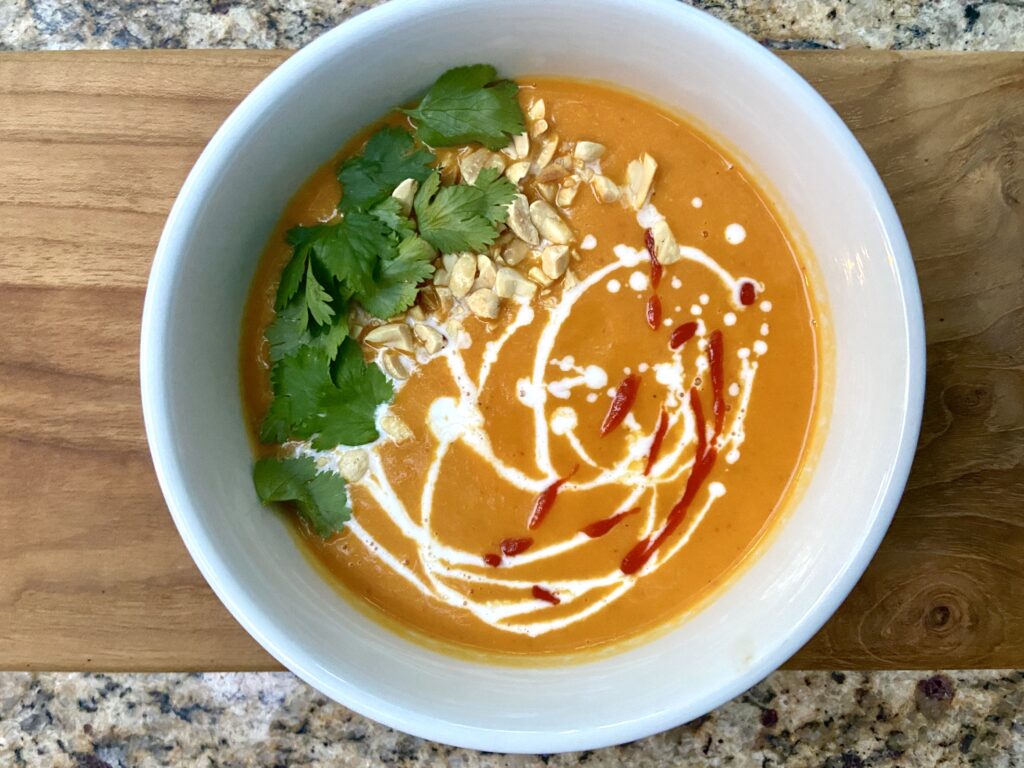
Recipe and Photos by Christina Hurt Smith.
I’m sure this has happened once or twice: you get your new CSA box, it comes with a huge bag of carrots but you haven’t yet finished your last huge bag of carrots. This is the very best way to use a bunch of carrots at once. This soup can also be prepared vegan if you leave out the fish sauce and use vegetable broth instead of chicken broth. One important thing: I have listed a specific brand for the red curry paste for a reason. Maesri curry paste is truly the best and can be found in most asian markets. Sure you could use another brand but I promise you, once you taste this you will never go back. With that said, if you are unable to find it, it’s not a deal-breaker. Your soup will be delicious anyway. Enjoy!
Curried Carrot and Sweet Potato Soup
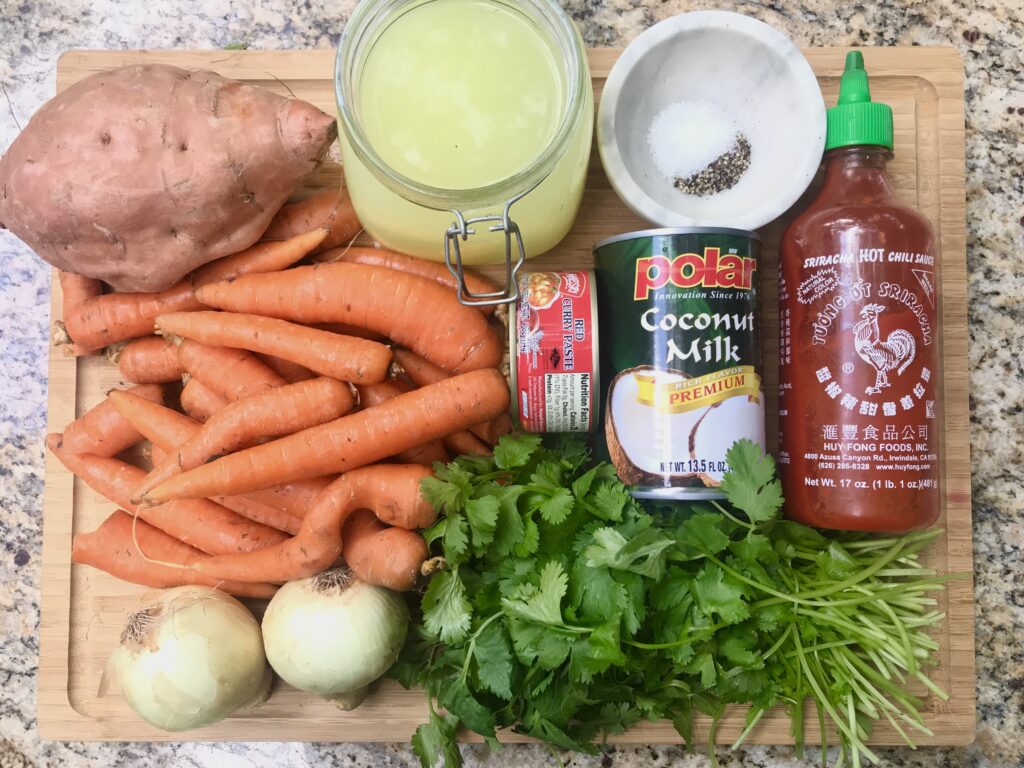
Ingredients:
- 1lb Carrots, peeled and chopped into 1in chunks
- 1 Sweet Potato, peeled and chopped into 1in chunks
- 1 Large Onion (or 2 small), diced
- 1 can (13.5oz) Coconut Milk, full fat
- 1 can (4oz) Maesri Red Curry Paste
- 3c Vegetable or Chicken Broth
- 2 tbsp Butter or Coconut Milk
- 1 tbsp Fish Sauce (optional)
- 1 tbsp Sugar
- Salt
- Pepper
- Garnish:
- Cilantro
- Toasted Peanuts
- Sriracha

Directions:
1. Heat a large pot to medium-high heat. Add butter or oil and toss in onion. Cook for 3 minutes until onion is translucent.
2. Add in red curry and coat the onions. Cook for 1 minute.
3. Toss in carrot and sweet potato chunks and stir to coat in onion and curry mixture. Cook for 5 minutes.
4. Add in broth. Place your lid on the pot and bring to boil. Once the mixture comes to a boil, turn heat to low and cook for 30 minutes or until the carrots and sweet potato are soft. Remove from heat.
5. Add sugar, fish sauce and can of coconut milk, reserving a little to garnish.
6. You can either use a hand emulsifier or you can let the mixture cool and blend in batches. Salt and pepper to taste.
7. Ladle soup into bowls and garnish with drizzle or reserved coconut milk, sriracha, toasted peanuts and cilantro.
CSA BOX CONTENTS WEEK OF JUNE 29TH
06/29/20 — Scott
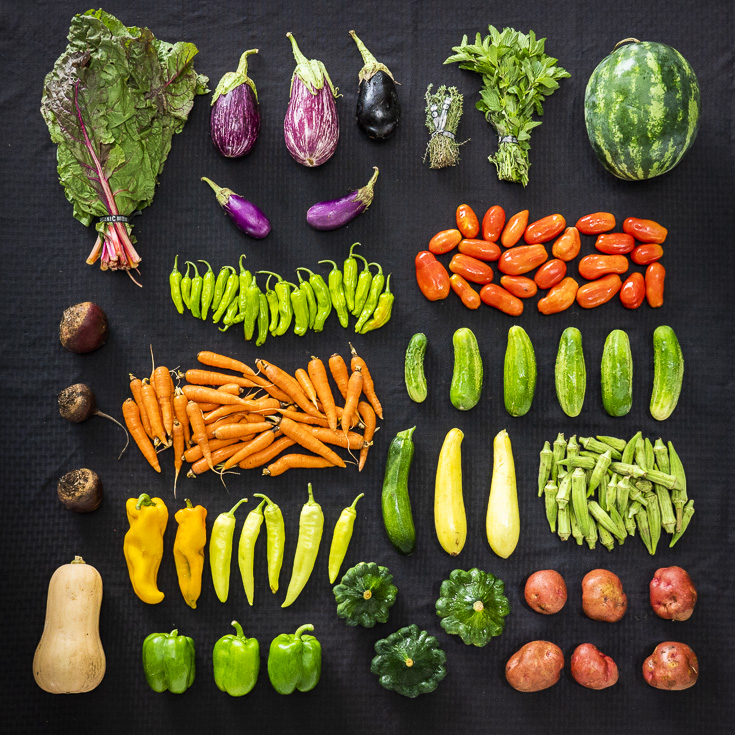 CSA Box Contents Week of Jun 29th
CSA Box Contents Week of Jun 29th
Large Box
Beets
Cabbage
Eggplant
Greens, Chard, Rainbow
Herb, Farmers Choice
Melon, Farmers Choice
Okra
Pepper, Sweet
Potato
Radish
Squash, Farmer's Choice
Tomato
Beets
Cabbage
Eggplant
Greens, Chard, Rainbow
Herb, Farmers Choice
Melon, Farmers Choice
Okra
Pepper, Sweet
Potato
Radish
Squash, Farmer's Choice
Tomato
Medium Box
Beets
Cabbage
Carrots
Farmers Choice
Melon, Farmers Choice
Pepper, Sweet
Potato
Squash, Farmer's Choice
Tomato
Beets
Cabbage
Carrots
Farmers Choice
Melon, Farmers Choice
Pepper, Sweet
Potato
Squash, Farmer's Choice
Tomato
Small Box
Beets
Eggplant
Farmers Choice
Herb, Farmers Choice
Melon, Farmers Choice
Pepper, Shishito
Tomato
Beets
Eggplant
Farmers Choice
Herb, Farmers Choice
Melon, Farmers Choice
Pepper, Shishito
Tomato
Individual Box
Carrots
Eggplant
Melon, Farmers Choice
Squash, Farmer's Choice
Tomato
Carrots
Eggplant
Melon, Farmers Choice
Squash, Farmer's Choice
Tomato






 0 ITEMS IN CART
0 ITEMS IN CART 

